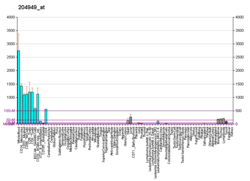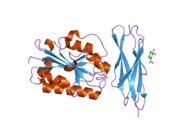| ICAM3 | |||||||||||||||||||||||||||||||||||||||||||||||||||
|---|---|---|---|---|---|---|---|---|---|---|---|---|---|---|---|---|---|---|---|---|---|---|---|---|---|---|---|---|---|---|---|---|---|---|---|---|---|---|---|---|---|---|---|---|---|---|---|---|---|---|---|
 | |||||||||||||||||||||||||||||||||||||||||||||||||||
| |||||||||||||||||||||||||||||||||||||||||||||||||||
| Identifiers | |||||||||||||||||||||||||||||||||||||||||||||||||||
| Aliases | ICAM3, CD50, CDW50, ICAM-R, intercellular adhesion molecule 3 | ||||||||||||||||||||||||||||||||||||||||||||||||||
| External IDs | OMIM: 146631; HomoloGene: 88479; GeneCards: ICAM3; OMA:ICAM3 - orthologs | ||||||||||||||||||||||||||||||||||||||||||||||||||
| |||||||||||||||||||||||||||||||||||||||||||||||||||
| |||||||||||||||||||||||||||||||||||||||||||||||||||
| |||||||||||||||||||||||||||||||||||||||||||||||||||
| |||||||||||||||||||||||||||||||||||||||||||||||||||
| Wikidata | |||||||||||||||||||||||||||||||||||||||||||||||||||
| |||||||||||||||||||||||||||||||||||||||||||||||||||
Intercellular adhesion molecule 3 (ICAM3) also known as CD50 (Cluster of Differentiation 50), is a protein that in humans is encoded by the ICAM3 gene. The protein is constitutively expressed on the surface of leukocytes, which are also called white blood cells and are part of the immune system. ICAM3 mediates adhesion between cells by binding to specific integrin receptors. It plays an important role in the immune cell response through its facilitation of interactions between T cells and dendritic cells, which allows for T cell activation. ICAM3 also mediates the clearance of cells undergoing apoptosis by attracting and binding macrophages, a type of cell that breaks down infected or dying cells through a process known as phagocytosis, to apoptotic cells.
Protein structure
ICAM3 is a 110–160 kDa protein that belongs to the intercellular adhesion molecule (ICAM) family. Like the other proteins in this family, ICAM3 is a type I transmembrane glycoprotein and consists in part of a hydrophobic transmembrane domain and a short domain that extends into the cytoplasm. ICAM3 also contains five extracellular immunoglobulin domains.
Function
ICAM3 is found on the surface of leukocytes, and the ICAM3 gene is constitutively expressed in these cells. Interactions between ICAM3 and specific integrin receptors facilitate adhesion between cells.
Dendritic and T cell binding
ICAM3 has an important function in the immune cell response, as it helps facilitate initial interactions between T cells and dendritic cells. Resting T cells show high levels of ICAM3 expression. ICAM3 on these T cells can bind to DC-SIGN, a transmembrane receptor present on dendritic cells, creating temporary contact between resting T cells and dendritic cells. This adhesion allows the T cell receptor (TCR) to interact with major histocompatibility complex (MHC) molecules on the surface of the dendritic cell, which, upon binding between the TCR, the MHC, and the peptide coupled to the MHC, facilitates T cell activation.
Apoptosis
ICAM3 plays a role in apoptotic cell clearance by promoting the movement of macrophages, which ingest and break down unhealthy cells via phagocytosis, to cells undergoing apoptosis. Apoptotic cells can release extracellular vesicles containing ICAM3, which acts as a chemoattractant to phagocytes such as macrophages, directing them toward apoptotic cells. Apoptotic cells also contain altered ICAM3 proteins on their surface. These altered proteins allow macrophages to specifically target and bind apoptotic cells. This process is believed to involve binding between ICAM3 and CD14 receptors, which are a type of cell surface receptor expressed on macrophages and other phagocytes.
Mast cells
ICAM3 is also found on mast cells, another type of leukocyte. Mast cells taken from human lungs and the HMC-1 line, a human mast cell line, both showed expression of ICAM3. ICAM3 helps mediate the adhesion of mast cells to the extracellular matrix.
Interactions
Dendritic and T cell binding
Binding between ICAM3 and DC-SIGN, which takes place during initial interactions between T cells and dendritic cells, occurs with high affinity. This binding process is also calcium-dependent.
Apoptosis
CD14, a receptor expressed on the surface of phagocytes, can also bind ICAM3. Interactions between CD14 and altered ICAM3 molecules on apoptotic cells are believed to help promote phagocytosis of apoptotic cells.
Integrins
ICAM3 is a known ligand for LFA-1, an integrin expressed by leukocytes. To facilitate binding, the I domain of LFA-1 interacts with the ICAM3 protein’s first immunoglobulin domain. ICAM3 also binds the integrin αDβ2.
Additional interactions
ICAM3 has been shown to interact with activated ERM proteins, including ezrin (EZR) and moesin, in T cells.
See also
References
- ^ GRCh38: Ensembl release 89: ENSG00000076662 – Ensembl, May 2017
- "Human PubMed Reference:". National Center for Biotechnology Information, U.S. National Library of Medicine.
- "ICAM3 intercellular adhesion molecule 3 [Homo sapiens (human)] - Gene - NCBI". www.ncbi.nlm.nih.gov. Retrieved 2022-03-10.
- ^ Xiao X, Mruk DD, Cheng CY (March 2013). "Intercellular adhesion molecules (ICAMs) and spermatogenesis". Human Reproduction Update. 19 (2): 167–186. doi:10.1093/humupd/dms049. PMC 3576004. PMID 23287428.
- ^ Pastwińska J, Żelechowska P, Walczak-Drzewiecka A, Brzezińska-Błaszczyk E, Dastych J (December 2020). "The Art of Mast Cell Adhesion". Cells. 9 (12): 2664. doi:10.3390/cells9122664. PMC 7764012. PMID 33322506.
- ^ Cockram TO, Dundee JM, Popescu AS, Brown GC (2021). "The Phagocytic Code Regulating Phagocytosis of Mammalian Cells". Frontiers in Immunology. 12: 629979. doi:10.3389/fimmu.2021.629979. ISSN 1664-3224. PMC 8220072. PMID 34177884.
- ^ Svajger U, Anderluh M, Jeras M, Obermajer N (October 2010). "C-type lectin DC-SIGN: an adhesion, signalling and antigen-uptake molecule that guides dendritic cells in immunity". Cellular Signalling. 22 (10): 1397–1405. doi:10.1016/j.cellsig.2010.03.018. PMC 7127357. PMID 20363321.
- ^ Gupta RK, Gupta GS (2012), Gupta GS (ed.), "Dendritic Cell Lectin Receptors (Dectin-2 Receptors Family)", Animal Lectins: Form, Function and Clinical Applications, Vienna: Springer, pp. 749–771, doi:10.1007/978-3-7091-1065-2_35, ISBN 978-3-7091-1065-2, retrieved 2022-03-11
- ^ Numata Y, Hirayama D, Wagatsuma K, Iida T, Nakase H (2018), Turksen K (ed.), "Apoptotic Cell Clearance in Gut Tissue: Role of Intestinal Regeneration", Autophagy in Health and Disease: Potential Therapeutic Approaches, Stem Cell Biology and Regenerative Medicine, Cham: Springer International Publishing, pp. 87–100, doi:10.1007/978-3-319-98146-8_6, ISBN 978-3-319-98146-8, retrieved 2022-03-09
- ^ Marek CJ, Erwig LP (2009), Dong Z, Yin XM (eds.), "Clearance of Apoptotic Cells – Mechanisms and Consequences", Essentials of Apoptosis: A Guide for Basic and Clinical Research, Totowa, NJ: Humana Press, pp. 261–282, doi:10.1007/978-1-60327-381-7_11, ISBN 978-1-60327-381-7, retrieved 2022-03-09
- ^ Smith CW (February 2008). "3. Adhesion molecules and receptors". The Journal of Allergy and Clinical Immunology. 2008 Mini-Primer on Allergic and Immunologic Diseases. 121 (2 Suppl): S375-9, quiz S414. doi:10.1016/j.jaci.2007.07.030. PMID 18241685.
- ^ van Kooyk Y, Geijtenbeek TB (August 2002). "A novel adhesion pathway that regulates dendritic cell trafficking and T cell interactions". Immunological Reviews. 186: 47–56. doi:10.1034/j.1600-065x.2002.18605.x. PMID 12234361. S2CID 23267228.
- Hawkins LA, Devitt A (January 2013). "Current understanding of the mechanisms for clearance of apoptotic cells-a fine balance". Journal of Cell Death. 6: 57–68. doi:10.4137/jcd.s11037. PMC 4147779. PMID 25278779.
- ^ Rahimi N (2020-12-22). "C-type Lectin CD209L/L-SIGN and CD209/DC-SIGN: Cell Adhesion Molecules Turned to Pathogen Recognition Receptors". Biology. 10 (1): 1. doi:10.3390/biology10010001. ISSN 2079-7737. PMC 7822156. PMID 33375175.
- Cornely R, Grewal T, Gaus K (2012), Kavallaris M (ed.), "The Actin Cytoskeleton and Membrane Organisation in T Lymphocytes", Cytoskeleton and Human Disease, Totowa, NJ: Humana Press, pp. 103–121, doi:10.1007/978-1-61779-788-0_5, ISBN 978-1-61779-788-0, retrieved 2022-03-09
Further reading
- Simmons DL (1995). "The role of ICAM expression in immunity and disease". Cancer Surveys. 24: 141–155. PMID 7553659.
- Hayflick JS, Kilgannon P, Gallatin WM (1998). "The intercellular adhesion molecule (ICAM) family of proteins. New members and novel functions". Immunologic Research. 17 (3): 313–327. doi:10.1007/BF02786454. PMID 9638475. S2CID 19901365.
- Fawcett J, Holness CL, Needham LA, Turley H, Gatter KC, Mason DY, Simmons DL (December 1992). "Molecular cloning of ICAM-3, a third ligand for LFA-1, constitutively expressed on resting leukocytes". Nature. 360 (6403): 481–484. Bibcode:1992Natur.360..481F. doi:10.1038/360481a0. PMID 1448173. S2CID 4310468.
- Vazeux R, Hoffman PA, Tomita JK, Dickinson ES, Jasman RL, St John T, Gallatin WM (December 1992). "Cloning and characterization of a new intercellular adhesion molecule ICAM-R". Nature. 360 (6403): 485–488. Bibcode:1992Natur.360..485V. doi:10.1038/360485a0. PMID 1448174. S2CID 4315548.
- Pino-Otín MR, Juan M, de la Fuente MA, Viñas O, Martínez-Cáceres E, Fernández MD, et al. (July 1995). "CD50 (intercellular adhesion molecule-3) is expressed at higher levels on memory than on naive human T cells but induces a similar calcium mobilization on both subsets". Tissue Antigens. 46 (1): 32–44. doi:10.1111/j.1399-0039.1995.tb02473.x. PMID 7482494.
- Marazuela M, Postigo AA, Acevedo A, Díaz-González F, Sanchez-Madrid F, de Landázuri MO (October 1994). "Adhesion molecules from the LFA-1/ICAM-1,3 and VLA-4/VCAM-1 pathways on T lymphocytes and vascular endothelium in Graves' and Hashimoto's thyroid glands". European Journal of Immunology. 24 (10): 2483–2490. doi:10.1002/eji.1830241034. PMID 7523142. S2CID 25833828.
- Holness CL, Bates PA, Little AJ, Buckley CD, McDowall A, Bossy D, et al. (January 1995). "Analysis of the binding site on intercellular adhesion molecule 3 for the leukocyte integrin lymphocyte function-associated antigen 1". The Journal of Biological Chemistry. 270 (2): 877–884. doi:10.1074/jbc.270.2.877. PMID 7822326.
- Martin S, Rieckmann P, Melchers I, Wagner R, Bertrams J, Voskuyl AE, et al. (February 1995). "Circulating forms of ICAM-3 (cICAM-3). Elevated levels in autoimmune diseases and lack of association with cICAM-1". Journal of Immunology. 154 (4): 1951–1955. doi:10.4049/jimmunol.154.4.1951. PMID 7836774.
- Bossy D, Mattei MG, Simmons DL (October 1994). "The human intercellular adhesion molecule 3 (ICAM3) gene is located in the 19p13.2-p13.3 region, close to the ICAM1 gene". Genomics. 23 (3): 712–713. doi:10.1006/geno.1994.1565. PMID 7851905.
- Skubitz KM, Ahmed K, Campbell KD, Skubitz AP (March 1995). "CD50 (ICAM-3) is phosphorylated on tyrosine and is associated with tyrosine kinase activity in human neutrophils". Journal of Immunology. 154 (6): 2888–2895. doi:10.4049/jimmunol.154.6.2888. PMID 7876557.
- Maruyama K, Sugano S (January 1994). "Oligo-capping: a simple method to replace the cap structure of eukaryotic mRNAs with oligoribonucleotides". Gene. 138 (1–2): 171–174. doi:10.1016/0378-1119(94)90802-8. PMID 8125298.
- Juan M, Vilella R, Mila J, Yagüe J, Miralles A, Campbell KS, et al. (July 1993). "CDw50 and ICAM-3: two names for the same molecule". European Journal of Immunology. 23 (7): 1508–1512. doi:10.1002/eji.1830230717. PMID 8325327. S2CID 23774801.
- de Fougerolles AR, Klickstein LB, Springer TA (April 1993). "Cloning and expression of intercellular adhesion molecule 3 reveals strong homology to other immunoglobulin family counter-receptors for lymphocyte function-associated antigen 1". The Journal of Experimental Medicine. 177 (4): 1187–1192. doi:10.1084/jem.177.4.1187. PMC 2190956. PMID 8459213.
- Hosaka S, Shah MR, Pope RM, Koch AE (March 1996). "Soluble forms of P-selectin and intercellular adhesion molecule-3 in synovial fluids". Clinical Immunology and Immunopathology. 78 (3): 276–282. doi:10.1006/clin.1996.0039. PMID 8605703.
- Van der Vieren M, Le Trong H, Wood CL, Moore PF, St John T, Staunton DE, Gallatin WM (December 1995). "A novel leukointegrin, alpha d beta 2, binds preferentially to ICAM-3". Immunity. 3 (6): 683–690. doi:10.1016/1074-7613(95)90058-6. PMID 8777714.
- Hayflick JS, Stine J, Fox R, Hoekstra D, Gallatin WM (August 1997). "Functional mapping of the cytoplasmic region of intercellular adhesion molecule-3 reveals important roles for serine residues". The Journal of Biological Chemistry. 272 (35): 22207–22214. doi:10.1074/jbc.272.35.22207. PMID 9268366.
- Serrador JM, Alonso-Lebrero JL, del Pozo MA, Furthmayr H, Schwartz-Albiez R, Calvo J, et al. (September 1997). "Moesin interacts with the cytoplasmic region of intercellular adhesion molecule-3 and is redistributed to the uropod of T lymphocytes during cell polarization". The Journal of Cell Biology. 138 (6): 1409–1423. doi:10.1083/jcb.138.6.1409. PMC 2132557. PMID 9298994.
- Suzuki Y, Yoshitomo-Nakagawa K, Maruyama K, Suyama A, Sugano S (October 1997). "Construction and characterization of a full length-enriched and a 5'-end-enriched cDNA library". Gene. 200 (1–2): 149–156. doi:10.1016/S0378-1119(97)00411-3. PMID 9373149.
- Bernstein CN, Sargent M, Gallatin WM (February 1998). "Beta2 integrin/ICAM expression in Crohn's disease". Clinical Immunology and Immunopathology. 86 (2): 147–160. doi:10.1006/clin.1997.4462. PMID 9473377.
External links
- ICAM3+protein,+human at the U.S. National Library of Medicine Medical Subject Headings (MeSH)
This article incorporates text from the United States National Library of Medicine, which is in the public domain.
| PDB gallery | |
|---|---|
| Proteins: clusters of differentiation (see also list of human clusters of differentiation) | |
|---|---|
| 1–50 | |
| 51–100 | |
| 101–150 | |
| 151–200 | |
| 201–250 | |
| 251–300 | |
| 301–350 | |



